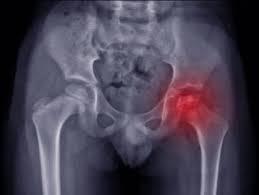
Legg-Calve-Perthes (LCPD) disease is a rare childhood condition that affects the hip, not the calf, even though the name might sound like it does. It is most common in boys aged 4-8, and about 90% of cases affect only one hip. I have been treating a 21-year-old female, which is why I wanted to talk about not only this condition but also how to manage it better as you age.
LCPD occurs when the blood supply to the femoral head (ball at the top of the thigh bone that fits into the hip bone) is temporarily interrupted, causing the bone to weaken and eventually die (called avascular necrosis). There is some genetic predisposition to getting LCPD, but there are other risk factors such as secondhand smoke exposure, trauma, or inflammation of the femoral head.
Symptoms include:
- Limping (usually asymptomatic at first)
- Hip, thigh, or knee pain
- Limited range of motion in the hip
- Muscle wasting in the thigh
If not treated properly, it can lead to permanent hip damage or early osteoarthritis in that hip, as well as compensatory injuries as you age. It can also lead to limitations in sports or active jobs, and even lead to hip replacement way earlier in life. If the patient fails conservative care or has significant pain, they will reshape the hip (called an Osteotomy) or do a hip preservation surgery (usually labral repair or debridement) to clean out the damaged tissue.
In kids, they will typically use casting, bracing, or assistive devices like crutches or a walker may be needed to limit weight-bearing on the affected hip. But treatment for adults is much different because the bone has already healed (usually in a deformed shape if untreated).
As we treat adults with LCPD, you have three objectives:
1. Manage Pain
2. Improve Function
3. Address Joint Damage (like arthritis or limited mobility)
Early on, we can utilize Winback Tecar therapy for pain relief and anti-inflammatory purposes; to break the vicious circle of pain/inflammation/stiffness; improvements in joint mobility; fibrolytic effects; reduction of edema; drainage of effusions; improvement of the healing process. Associated with a reduction in recovery time and accelerated return to normal activities.
It is contraindicated to manipulate the affected hip, but we can manipulate or address other joint hypomobilities in the spine. We also can utilize the rehabilitation side of things to improve things like gait imbalances, hip mobility and stability, and increase overall hip strength. This is vital, and the earlier you can manage this, the better the long-term prognosis the patient will have. My patient also had pain and discomfort on the opposite side of her affected hip and in her lower back from years of compensation and wants to not only be pain-free, but also train at a high level in the gym because that’s important to her. She is currently crushing it and feels so confident that she is entering a powerlifting competition by the end of this year.
If you have had LCPD or hip pain, schedule a FREE discovery visit so we can sit down and talk about how we can help.
.jpg)
.jpg)
